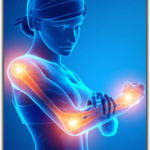
Rotator Cuff
The rotator cuff is made up of four muscles and their tendonous connections to the humeral head— the ‘ball’ portion of the ball and socket joint of the shoulder. (picture). When a person talks about rotator cuff tears, these happen in the tendon of one of the rotator cuff muscles – – the supraspinatus, infraspinatus, subscapularis and teres minor. The supraspinatus is by far the most common tendon that tears.
Traditionally, rotator cuff tears had been treated by open or arthroscopic surgery where the tendon is either sutured back together or reattached to the humerus. Many of these surgeries can be successful.
In a regenerative model, all of the contributing factors that caused the rotator cuff tear are considered – – neck dysfunction, nerve impingement, arthritis, posture, poor motion and alignment and scarring within fascia planes. Beyond that, as we have discussed further in the website the immune system, endocrine system, medications, supplements and even mood can affect function, motion and structure that will lead to injuries and tears.
Careful analysis with ultrasound, x-ray and MRI are all necessary to fully appreciate the contributing factors – – combined with physical therapy, chiropractic and functional medicine evaluations.
Of special importance to this region, neurologic dysfunction and abnormal stress caused by pain and degeneration in the neck occurs in greater than 50% of the patient’s treated by Dr. Hansen with rotator cuff pathology over the last 12 years. This underlying cause is not adequately assessed and treated as part of rotator cuff injuries, other forms of treatment including surgery are likely to either be unsuccessful or lead to recurrence of the problem.
See diagram two. The acromio–clavicular joint, sterno – clavicular joint, glenohumeral joint, superior glenohumeral ligament and biceps tendon are all structurally, mechanically and functionally very important structures to assess for treatment when the rotator cuff is being considered for regenerative therapies.
Special additions to simply injecting the rotator cuff tear are also important to consider. The presence of calcifications within the tendon should be assessed and potentially removed by Barbara Taj procedure. If the pair is large enough, using specific proteins to hold the terror together while it heals is critical. The right choice and were mixture of regenerative agent for the size and type of peer is crucial to optimize healing. Bracing in the correct position for optimal healing must be assessed. Injecting stimulating regenerative agents into all of the muscles of the rotator cuff helps to activate them leading to decreased pain and improve speed of healing after procedures. Appropriately blocking and modulating nerve function with anesthetics and regenerative agents in four different nerves both decreases pain during the procedure and helps modulate neurologic function in the healing process – – this long term is it helping decreasing pain and improving range of motion/function.
